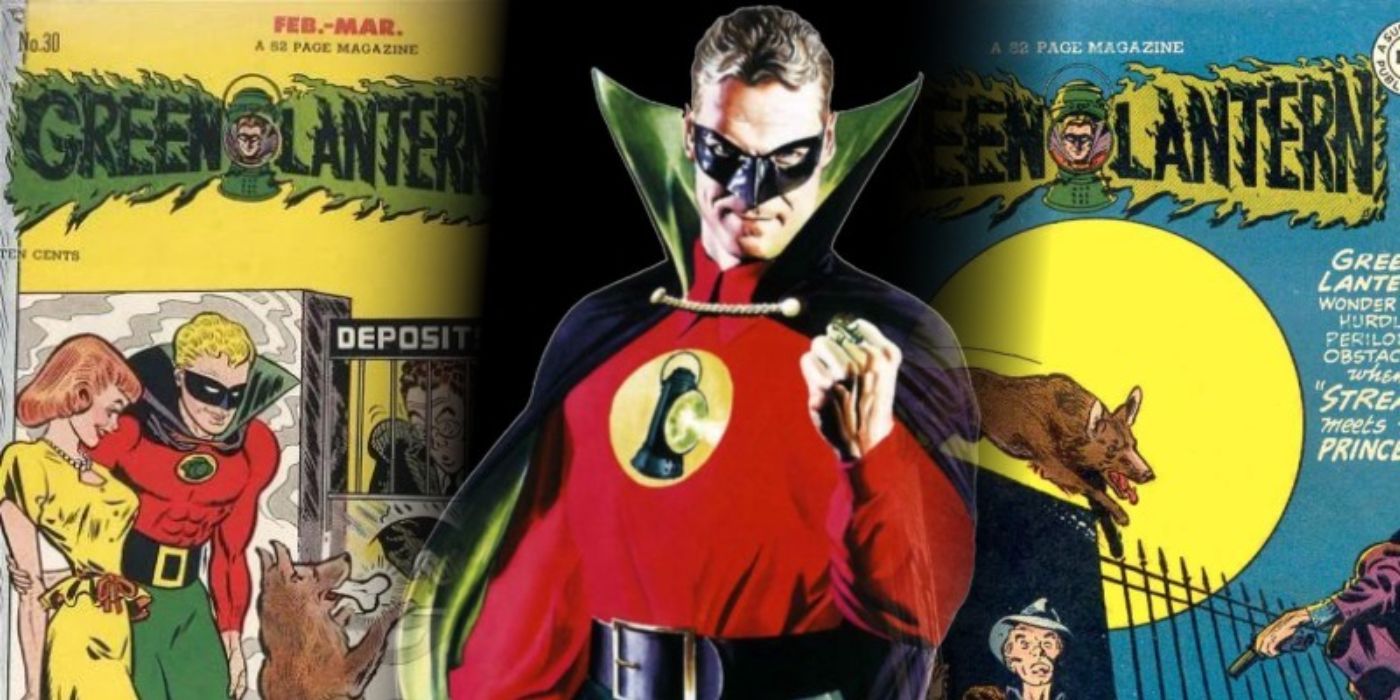Summary
The Green Lanterns’ legacy is associated with Hal Jordan, John Stewart and the Green Lantern Corps but it actually started back in the Golden Age of comics, when Alan Scott was the first hero to wield a Green Lantern ring. Despite this pedigree, DC Comics has mostly overlooked him in recent years, a tradition that started when he was upstaged by an unlikely co-star.
Toward the end of his solo tenure as Green Lantern, Alan Scott was replaced by Streak the Wonder Dog. Though it only lasted for a few issues before the pair’s book came to a close, it was a sign of things to come for Hal Jordan’s predecessor. In fact, he’s still recovering from the ways a canine usurped him back in the Golden Age.
RELATED: DC’s New Golden Age Brings Back the Red Lantern
Crafted by Batman co-creator Bill Finger and artist Martin Nodell, the Alan Scott Green Lantern debuted in All-American Comics #16. He was one of many hit heroes of the era, not to mention a founding member of the Justice Society of America. Alongside Superman, Batman, Wonder Woman, The Flash and Hawkman, he helped define DC’s time during the Golden Age of Comics. As the initial dawn of superheroes came to a close, however, all but the most popular characters were on the chopping block. That included the original Green Lantern, who had a particularly embarrassing goodbye.
In 1948, Issue #30 of Green Lantern introduced Streak the Wonder Dog. Taken in by Alan Scott after becoming entangled in a murder case, Streak became the Green Lantern’s newest sidekick. Scott already had a partner in the form of the comical Doiby Dickles, but Streak was treated and drawn more seriously. This was the dawn of what some scholars call the Atomic Age of Comics when superheroes’ popularity waned and publishers were willing to try literally any alternatives. Streak was ahead of the curve, preceding Krypto the Super Dog’s and Ace the Bat Hound’s first appearances by almost a decade. From issue #34 until #38 (the series’ conclusion), Streak was featured on almost all of Green Lantern‘s covers and Alan Scott nearly vanished, despite still being the series’ star. The Golden Age Green Lantern didn’t reappear until nearly 15 years later in The Flash #137 (1963).
This series was a vehicle for the new Barry Allen Flash, however, setting the Golden Age heroes’ adventures on an alternate Earth. At this stage, the Justice Society characters almost exclusively showed up in team-ups and crossovers with their Earth-One counterparts. Even when these Golden Age heroes finally got new books like Infinity, Inc., in the 1980s, the stories focused on the original JSA’s children, including Alan Scott’s daughter, Jade. After his initial run, Streak the Wonder Dog was never really mentioned much, on Earth-Two or any other world. In fact, he’d essentially been replaced by Rex the Wonder Dog, who appeared in 1952 and occupied a similar space in the rest of DC’s Atomic Age Comics. Even with Streak out of the picture, however, Alan Scott never found his way out of the doghouse.
RELATED: 10 Harsh Realities Of Reading Old Green Lantern Comics
DC’s Original Green Lantern Is Stuck In The Green Lantern Corps’ Shadow
For the most part, even the most diehard DC fans don’t know that Alan Scott was displaced by a dog in his own book. That said, Scott has also been a niche character almost since his inception. The Justice Society was originally conceived of as a launching place for characters that weren’t strong enough to support their own books, and Scott’s not been a solo hero for several decades. In fact, the upcoming Alan Scott: The Green Lantern will be his first title in over fifty years.
Alan Scott suffers from a unique problem; he’s almost completely incongruous with the modern Green Lantern Corps mythology. DC established a tentative tie to this cosmic group through retcons but it’s not enough to make him really belong in contemporary comics. In contrast, Jay Garrick’s Flash fits in perfectly with Barry Allen, Wally West, and the other Scarlet Speedsters, and his return following DC Rebirth was a sign that the DC Universe’s legacy was back in full force. Alan Scott felt nearly superfluous to the Green Lanterns’ lore. In the ’90s, he even changed his name to Sentinel, making Kyle Rayner the only Green Lantern following Hal Jordan’s fall from grace. Again, this only pushed Scott further into JSA-related obscurity and made him feel less relevant. Even when the Green Lantern books were at their hottest under Geoff Johns’ direction, the Golden Age Green Lantern’s ship wasn’t raised by their tide.
RELATED: How Stargirl: The Lost Children Expertly Avoided Spider-Man’s Big Sidekick Problem
Even Hawkman’s muddled reincarnation hijinks have worked out better for him than Alan Scott’s retcons since they can still be reconciled with the Thanagarian Hawkman (as shown by Geoff Johns and Robert Venditti). Then there are legacies like The Atom’s, none of whom are particularly popular in or outside comic books. Nevertheless, even Al Pratt, the Golden Age Atom, had a small role in 2022’s Black Adam. Similarly, the 2023 Blue Beetle movie established that Jaime Reyes was preceded by Ted Kord and Dan Garrett, the Golden and Silver Age Blue Beetles. Even in the midst of far more popular legacy characters, these old-school do-gooders still clearly have a place for creators who love DC’s history.
When the first Green Lantern was replaced by a dog, it was a preview of his future as DC’s perennial third wheel. While retcons helped develop Alan Scott’s character as a gay man, they did little to change his importance for the publisher. Even Alan Scott’s upcoming series and the additions made to his mythos via Geoff Johns’ The New Golden Age simply involve repackaging concepts from the cosmic Green Lantern Corps. Hopefully, this will be enough to give Alan Scott a narrative foundation that doesn’t involve goofy sidekicks or unrelated canines. Until then, however, the hero’s best days ended when he was replaced with man’s best friend.
Alan Scott was DC Comics’ first Green Lantern, but he’s relatively obscure. This started when he was replaced by a dog in his own comics. Read More

